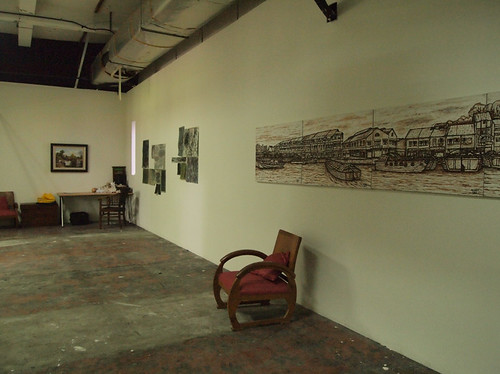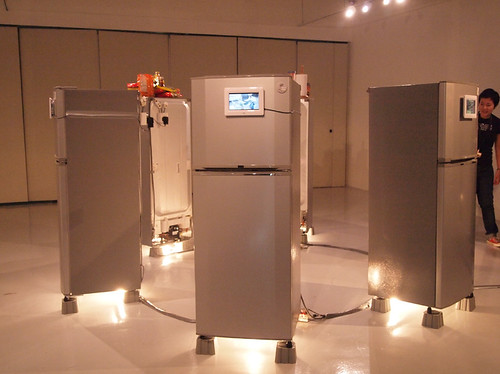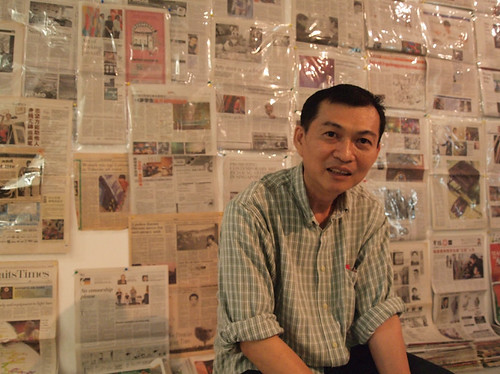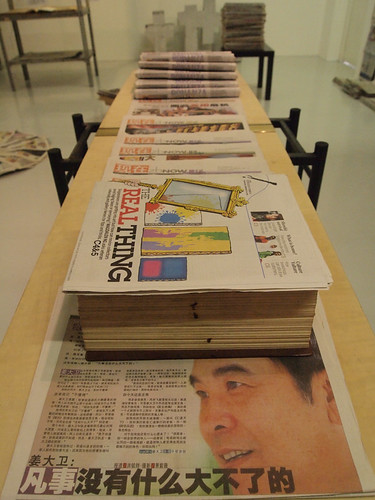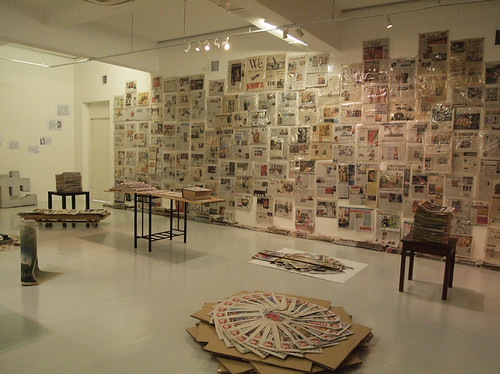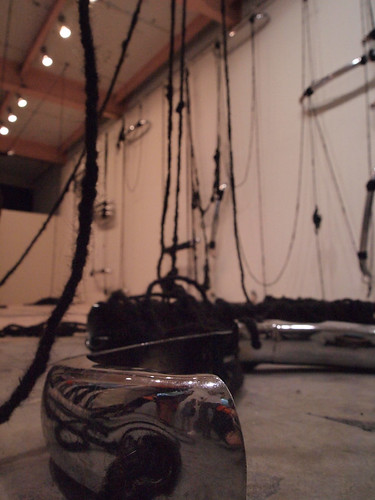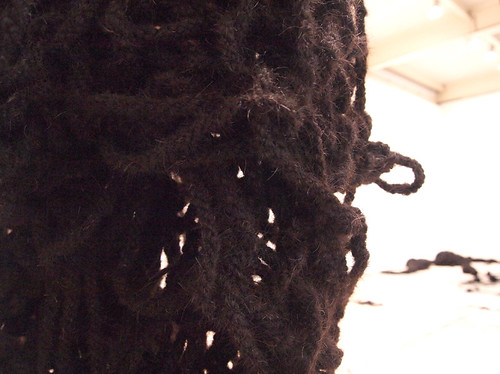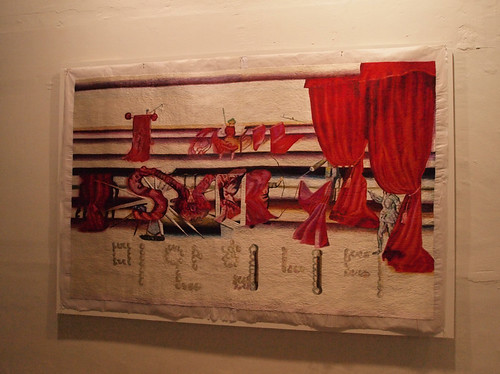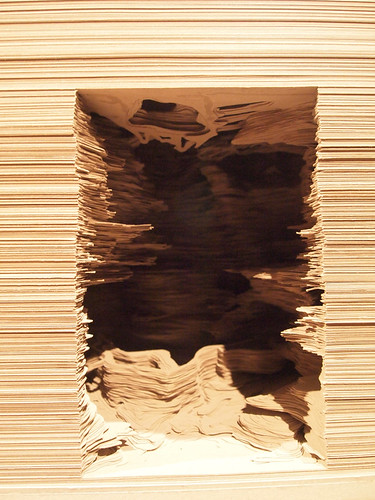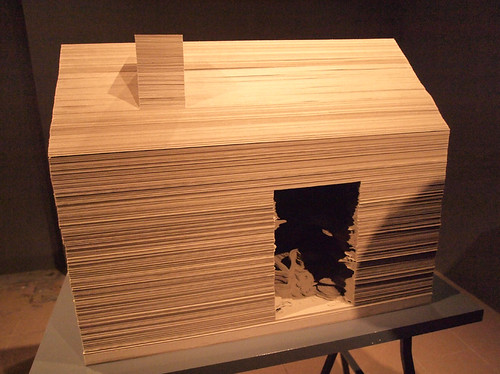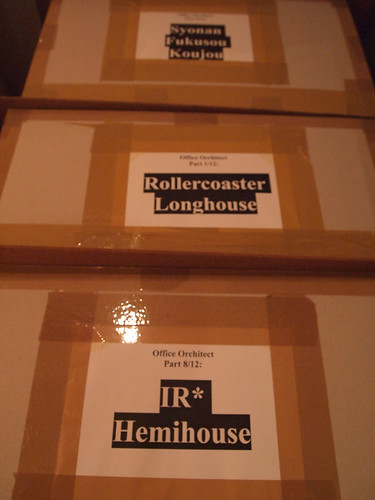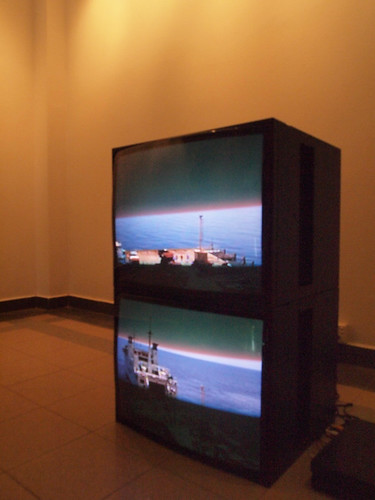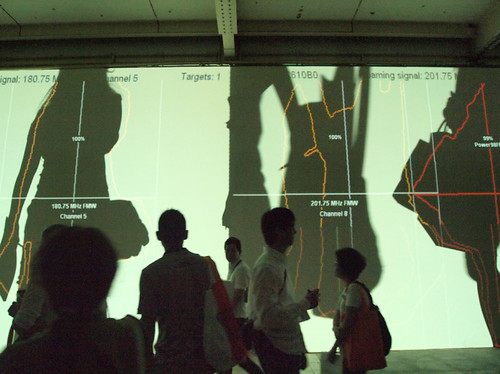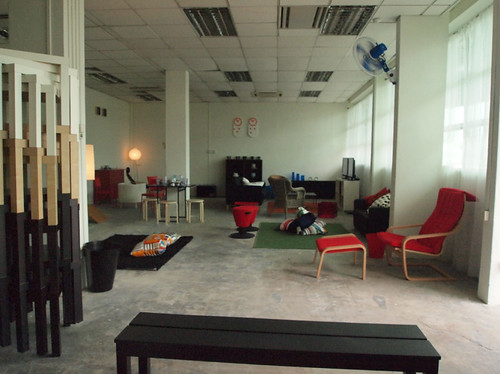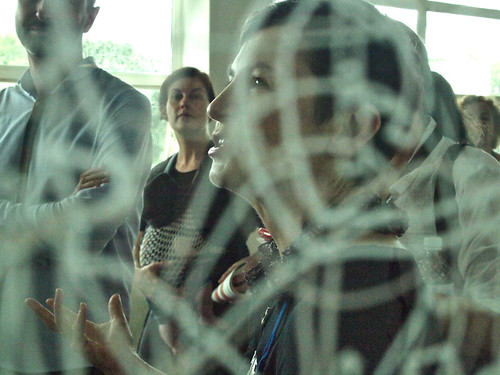Hot on the heels of Art Stage Singapore is the Singapore Biennale; a contemporary art exhibition that aims to foster dialogue through shared experience. The Biennale entitled, ‘Open House’ differs from Art Stage because provides insight into the artistic process instead of merely showcasing finished pieces of art. Each of the four destinations housing a total of 161 works has its own set of themes and demonstrates a diversity of contemporary art practices from around the world. With an emphasis on artistic process, real connections and spatial relationships, more than half of the artists will be creating new site-specific commissions.
The works situated at SAM and SAM at 8Q revolve around issues of ‘personal space, personal experience, personal collections, personal choice and personality’. The works situated at the National Museum of Singapore paint pictures of the slow destruction brought about by ‘media hyped images, technological advancements, globalization, consumerism and commerce’. The works situated at the Old Kallang Airport feature ‘ideatic responses’* to issues such as, ‘travel, transformation, exchange, displacement, and movement’. And the works situated at Marina Bay bridge the gap between the ownership of ‘public and private space’ as well as seek to give tangible form to memories and experience. All the exhibits invite us into private and public spaces that we would otherwise be unable to experience. Hence the title, ‘Open House’. The exhibition venues each have a direct conceptual link to the artworks.
What is so great about the goal of this year’s Biennale is that it coincides with the role of the contemporary artist; which is to fill the gaps between spaces in society. The artists’ interpretation of life usually provides a means to which we are able to see beyond our own context and comfort zones to develop a more compassionate understanding for others. The 63 artists (9 of which are Singaporean) involved this year practice and exhibit not just to represent something about the world but also to make real attempts to exchange information, translate experiences and even trade places.They are in fact, “Looking for connections that might otherwise not seem to be there.”
Here are some exhibits I would like to share with you.
The Secret Affair 2010 – 2011 | Roslisham Ismail aka ISE, Kota Bahru Malaysia
Food Installation (Work in Progress)*, SAM 8Q, Level 2
Walk into the room and you enter a clinical environment where you see 6 refrigerators with screens layed out in an octagonal shape reminding you somewhat of incubation bays in a Japanese anime. Open the doors however and you see the contents of a typical refrigerator. ‘The Secret Affair’ is the culmination of 2 months worth of interactions between the artist and 6 different Singaporean families. This project arose out of the simple curiosity the artist feels one would have when you visit another’s home. What would he have in his refrigerator? It is the simple concept that goes beyond ‘you are what you eat’ and looks at what where you buy your food and how you categorize the contents of your refrigerator tell about the character and how those characters are present in every facet of society. This art pieces also represents a dialogue with ‘Food for Thought’ the café at the ground floor of 8Q. The café will be creating special menus from the contents of these refrigerators.
Artists in the News, 2011 | Koh Nguang How, Singapore
Newspaper archive (Work in Progress)* SAM 8Q, Level 3
Singapore’s very own independent art historian Koh Nguang How initiated one of the exhibits that received the most attention. His ‘Artists in the News’ archival project was one of the most significant and media covered exhibit this year. The archivist who has been documenting and collecting materials relating to contemporary art in Singapore since the late 1980s presented part of his vast documentation for the Singapore Biennale. In an age where information is easily available online, Koh’s documentation of the Artists Village between 1989 and 1999 has become a significant offline historical resource. For the Biennale, Koh constructed within the gallery an actively morphing archival laboratory that replicates the configuration of his apartment. The three decades worth of material serves to educate current contemporary artists as well as the public on the practices and artworks of Contemporary Artists within different periods of history so that we may examine why they were considered ‘contemporary’ during their time. What added to the ‘active’ feature of the gallery was the fact that visitors and students got to interact with the artists (most whom by now are in their late 60s or 80s) featured in the newspapers when they visited Koh’s exhibit as well as participate in drawing and sketching. Throughout the Biennale Koh chronicled these meetings as well the morphing of the newspapers into raindrops, on his facebook account, thereby transcending the barrier between offline and online ‘exhibition’. Even girl next-door Candice Breitz of Factum could not help but state that she was impressed by the commitment and historical importance of this cleverly disguised political piece. If you care about art in Singapore, then you do certainly have to go visit him. And I say ‘visit’ because he will be there everyday in a corner makeshift office by the door till the day the Biennale closes. This is a piece where you will be able to see what an artistic process sometimes does to an artist and vice versa what an artist can do with a process.
Factum, 2010 | Candice Breitz, Johannesburg, South Africa
Video and sound Installation, SAM 8Q, Level 3
Using twin siblings as a subject matter, Candice investigates the process in which people try to distinguish themselves from others. It is an inquiry into the importance of forming a unique identity.
Elmgreen & Dragset work, 2011| Copenhagen Denmark
Installation, Old Kallang Road, Hanger
Meandering the topic of ‘displacement’, this is the duo that created the Prada Marfa piece in Texas where they placed a Prada store in the middle of the desert. The original plan was to leave it to degrade naturally into the natural habitat. For this year’s Biennale they have recreated an authentic German Barn in the airplane hanger of Old Kallang Airport. It was made with the intention of stimulating the senses and starting a discussion on what contemporary art is. The installation also features four young men dressed in traditional leather pants, relaxing in the hay with books and diaries in hand, something that really had visitors talking and clicking. Makes me wish they had real goats running around the barn.
Behold, 2009 | Sheela Gowda | Bhadravati, India
Installation, Old Kallang Airport, East Block, Level 1
‘Behold’ by Sheela Gowda from Bhadravati India, is a powerful piece that highlights the extraordinary gravity of unacknowledged marginalized labor in India. It is a large-scale installation with twenty steel car bumpers entwined in a meticulously woven four km rope of human hair, coiling its way through the gallery space. In Bengaluru, the capital of the Indian state of Karnataka, it is a custom for short lengths of hair to be woven together as talismans and tied around car bumpers to ward off accidents and the evil eye. The hair used originates from pilgrims who have shaved their heads as a sacrifice. This brusque display, enhanced by the unconventional pairing and painstakingly woven feature of the artwork, contrasts the history of a ritual that brings about peace of mind to the harsh reality of ignorance, with regards to the invisibility of labour in India. It is her self-expression of an external issue in response to a socio-political situation. Showing what preoccupies and concerns her artist mind with regards to the world around her.
Gowda’s large-scale works are often triggered by the transactions she observes in her daily life in Bangalore. Upon observation, she seeks to transform, or abstract, them further, with the aim to find a visual language in which the references and connections are there, but not in a way that the viewer gets bogged down by the need to know the entire story, for work to be relatable.
Various Works 2010 | Kyungah Ham | Seoul, South Korea
Fabric Installation, Old Kallang Airport, West Block, Level 2
Kyung Ham’s embroidery work is a social fabric in which the process of producing the artwork is as precarious as the message itself. The commissioned images usually contain material that is censored in North Korea and is an attempt by the artist to reach out across a closed barrier.
Office Orchitect, 2011 | Michael Lee | Singapore
Book sculptures, Old Kallang Airport, East Block, Level 1 & 2
Michael Lee’s work for the Biennale creates a world in which human desires have an organic effect on architectural spaces. His anthropomorphic book sculptures corroded, transformed and determined by such psyches have painstakingly been created out of paper.
All lines flow out, 2011 | Charles Lim | Singapore
Video installation, Old Kallang Airport, West Block, Level 2
Perhaps especially poignant to the theme of invisible connections is this work by the husband of local film maker Wee Li Lin. His exhibition, focusing on the transient nature of water, traces hidden journeys from one part of the island to another weaving in intricate relationship between the different channels of flow.
Frequency & Volume: Relational Architecture 9 2003 | Rafael Lozano-Hemmer | Mexico City
Interactive installation, Old Kallang Airport, East Block, Level 1
This work features an interactive space in which patrons function as antennas igniting a spectrum of radio frequencies that play as they interact with the exhibit. Patrons experience immediacy in connection with the environment and yet distance from each other. This artist’s interest lies in exploring issues of personal intimacy in public realms.
Untitled 2011 | Arin Rungjang | Bangkok, Thailand
Installation (Work in Progress)* Old Kallang Airport, Terminal Building, Level 1
Very similar to Roslisham Ismail’s Secret Affair, Arin Runjang’s work is the end result of a process that began with him interacting with Thai migrant workers in Singapore. The space he created functions both as a meeting ground and a venue for exchange where his subjects will swap things they own for the ikea pieces that furnish the space. It is his aim that inviting this physical exchange of objects also invites an exchange of experiences and stories between them and the Biennale Patrons.
Contraband 2010 | Taryn Simon | New York, USA
Installation, Old Kallang Airport, West Block, Level 2
Contraband is a documentation of prohibited items that have been confiscated from airline passengers and express mail. It represents the inner workings of establishments and individuals that have access to privilege and power. Chronicling a world that is divided by culture, resource and wealth. This was one of the exhibits that I was more excited about, where the curiosity was the main attraction. I was disappointed however to see that they were not the real items themselves but inkjet prints in Plexiglas boxes.
Within 2011| Gosia Wlodarczak | Banie, Poland
Frost drawings, Old Kallang Airport, Terminal Building, Level 2
Within is a delicate piece sculpted from the artist’s absorption of time, movement, light and memory of the artist’s breathing space. Wlodarczak seeks to freeze aspects of the consistently shifting and changing world outside. Imprinting traces of life into the walls that represent observers of time.
The Merlion Hotel 2011| Tatzu Nishi| Nagoya, Japan
Installation, Merlion Park, beside Fullerton Hotel
The Merlion Hotel is a temporary hotel that gives the public a very personal experience of a very public local icon.
I will send you to a Better Place 2010| Zai Kuning| Singapore
Immaterialized Proposal, The Substation Garden, Singapore Biennale 2011 Catalogue
Zai Kuning’s ‘I will send you to a Better Place’ is very similar to the Koh Nguang How’s ‘Artists in the News’ in the sense that it is also a crusade to keep the past alive. He wanted to have Timbre suspend its operations for 2 months and reinstate The Substation Garden; a space where artists and poets used to perform. Stating that this proposal was ‘meant to fail’, Zai uses the media to feature the ‘act of that rejection’ as the outcome of his artistic process. Read more about the project here. Check out his correspondence with Martin Mayo in Today.
There are still many exhibits that I have not visited but all in due time.
So what is the significance of such an exhibition in Singapore and what will it do for us? Many of the works in this year’s Biennale aim to soften the threshold of experiential indifference and ignorance present in society today. The art pieces not only depict a ‘visual’ attempt to ‘relate’, they seek to develop relationships as well. From broader differences grounded by social and political hierarchies to cultural and economic divides and personal differences such as personality and taste. Many of these barriers once broken down, reveal unexpected connections between culturally divergent situations.
Perhaps it is coincidental that the theme in this year’s Biennale is very much an artistic representation of Singapore, a port of trade that serves as a venue for exchange. Perhaps it is through this exhibition that we as Singaporeans might seek to understand ourselves in search of that seemingly ‘elusive’; Singaporean Identity.
I find it very important to stress that The Biennale is not going to and will never be an art fair, that shows finished work like paintings and sculpture for sale. It is an exhibition that features personal artist work or commissioned work that aims to communicate and bridge gaps in society. What the artist delivers, is the result of processing the experiences and information he exposes himself to. And we are all the better for giving ourselves a chance to visit these artworks with an open mind as well.
* ideatic responses – where the final art piece is the representation of an idea
* work in progress – works that continue building upon themselves at the site of exhibit
VISITOR INFORMATION
Biennale Venues
SAM & SAM at 8Q
National Museum of Singapore
Old Kallang Airport (Old People’s Association Building) Near Kallang Mrt
Marina Bay (Fullerton Area) more info.
*Choose appropriate foot wear, as there will be a lot of walking especially at Old Kallang Airport.
* Shuttle services are available at all venues. more info(left sidebar)
Admission Details
Adult $10, Student $ 5, Senior citizen 60 years and above $5
Free Admission: Old Kallang Airport & Marina Bay
*Visitors 6 years and under
*Singaporean or Permanent Resident senior citizens
*Full-time National Servicemen (NSFs)
*Students and teachers from local schools
(Please produce valid identity documents to enjoy the free admission.)
*Each Ticket includes one-time entry to all venues (need not be visited on the same day),
*One complimentary Short Guide and one-time free audio guide rental at all venues.
Biennale Guides
An audio tour in English is available at SAM, SAM at 8Q, National Museum of Singapore and the Old Kallang Airport.
* You need to swap your driver’s license or identity card for it.
*The audio guide is free with every ticket purchased or $3 for those who enjoy free admission.
* It is available as a downloadable Smartphone application on iTunes and the Android Marketplace at $3.
* Short Guide at $5 is available for those who enjoy free admission (no admission ticket purchase).
* Free-guided tours are available from 19 March
Biennale Officials
Artistic Director: Matthew Ngui
Curators: Russell Storer and Trevor Smith
Director of SAM: Mr Tan Boon Hui
Singapore Biennale 2011 ‘Open House’ is organized by the Singapore Art Museum (SAM) of the National Heritage Board and supported by the National Arts Council, Singapore.

Artitute
is an online showcase and magazine covering Southeast Asia’s established and emerging visual artists and art scenes.

